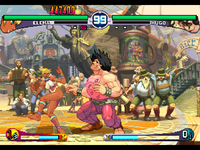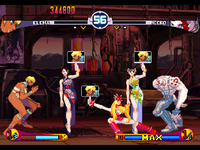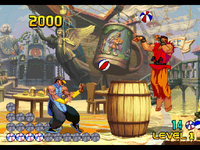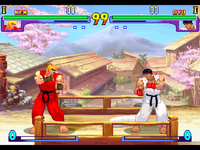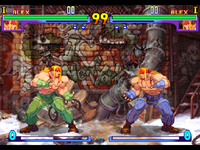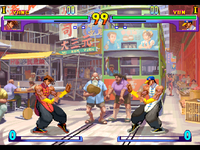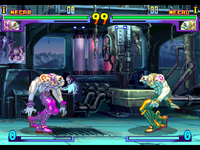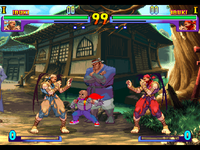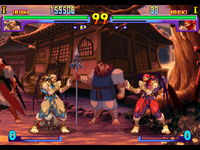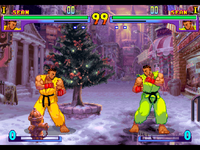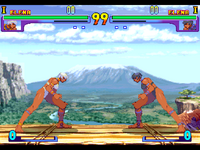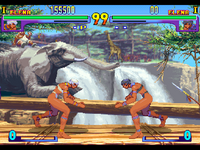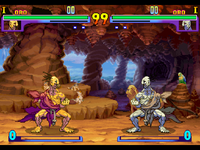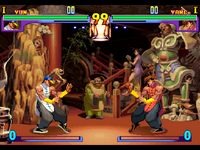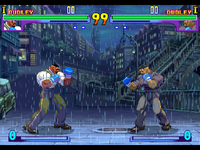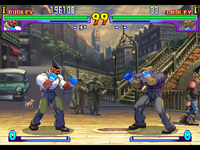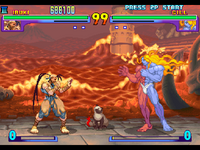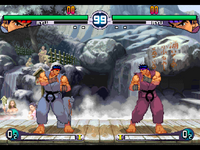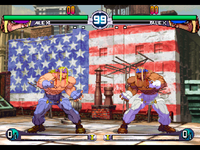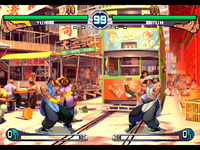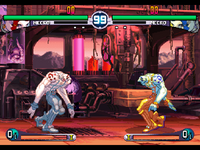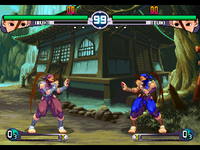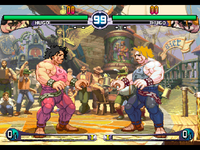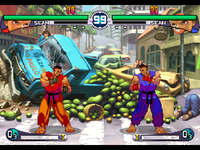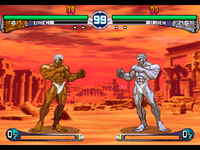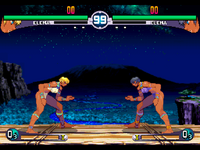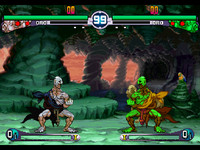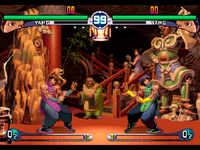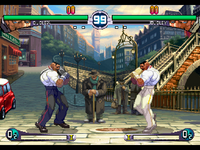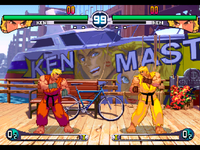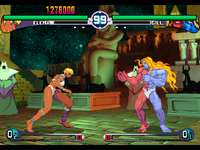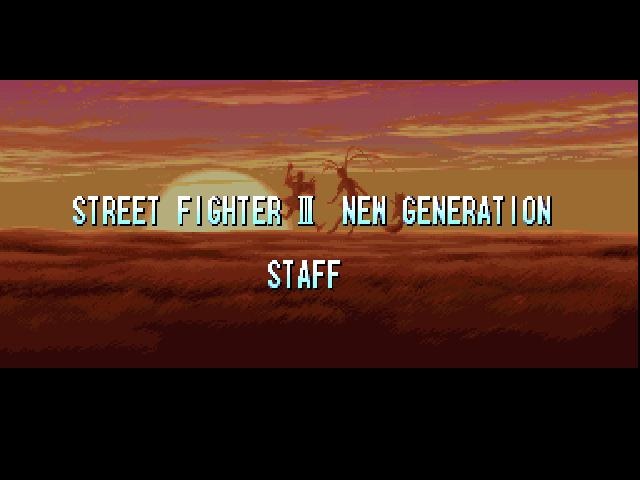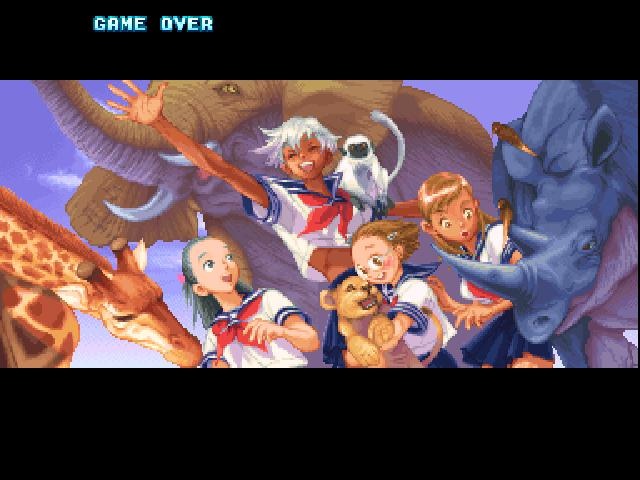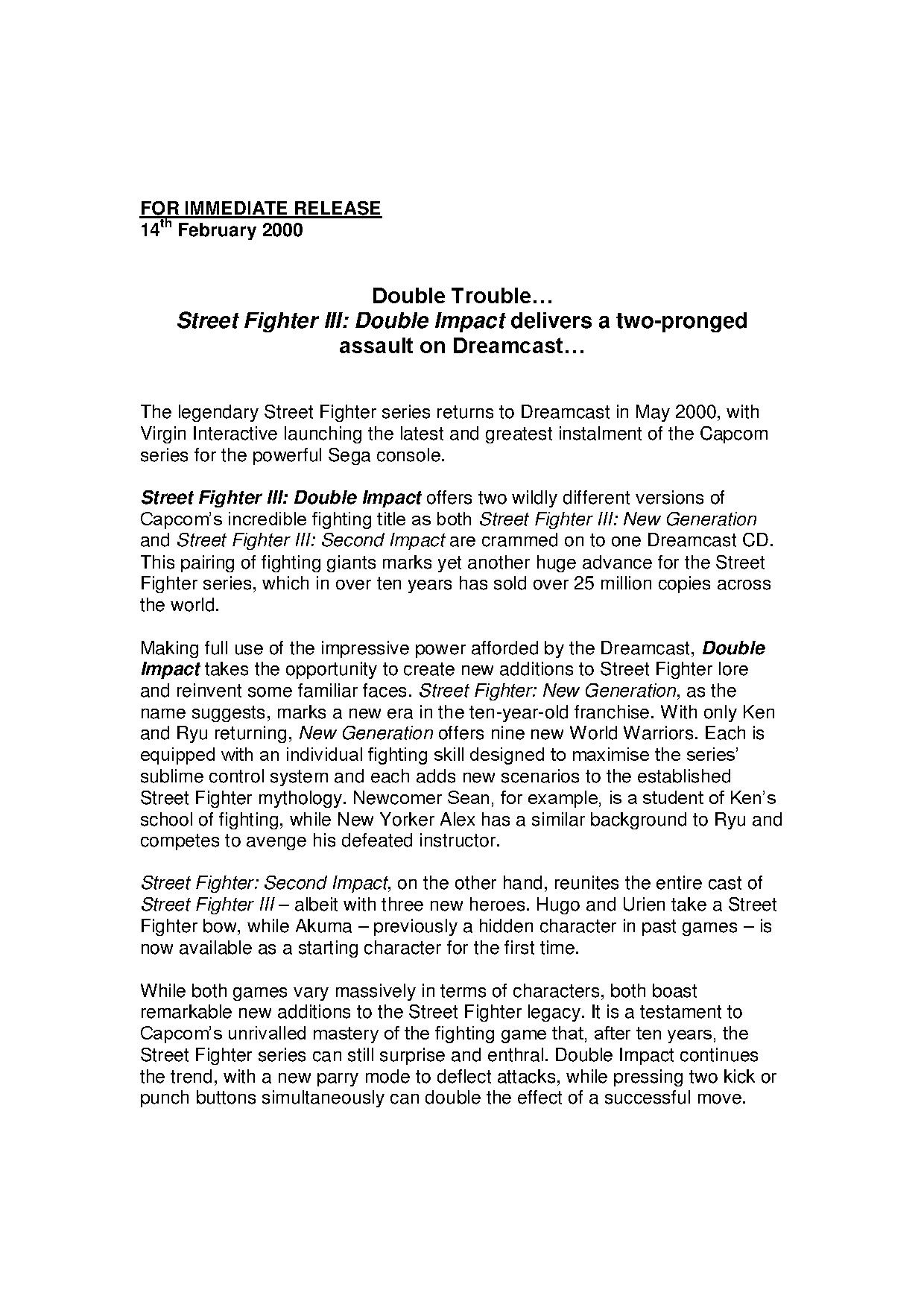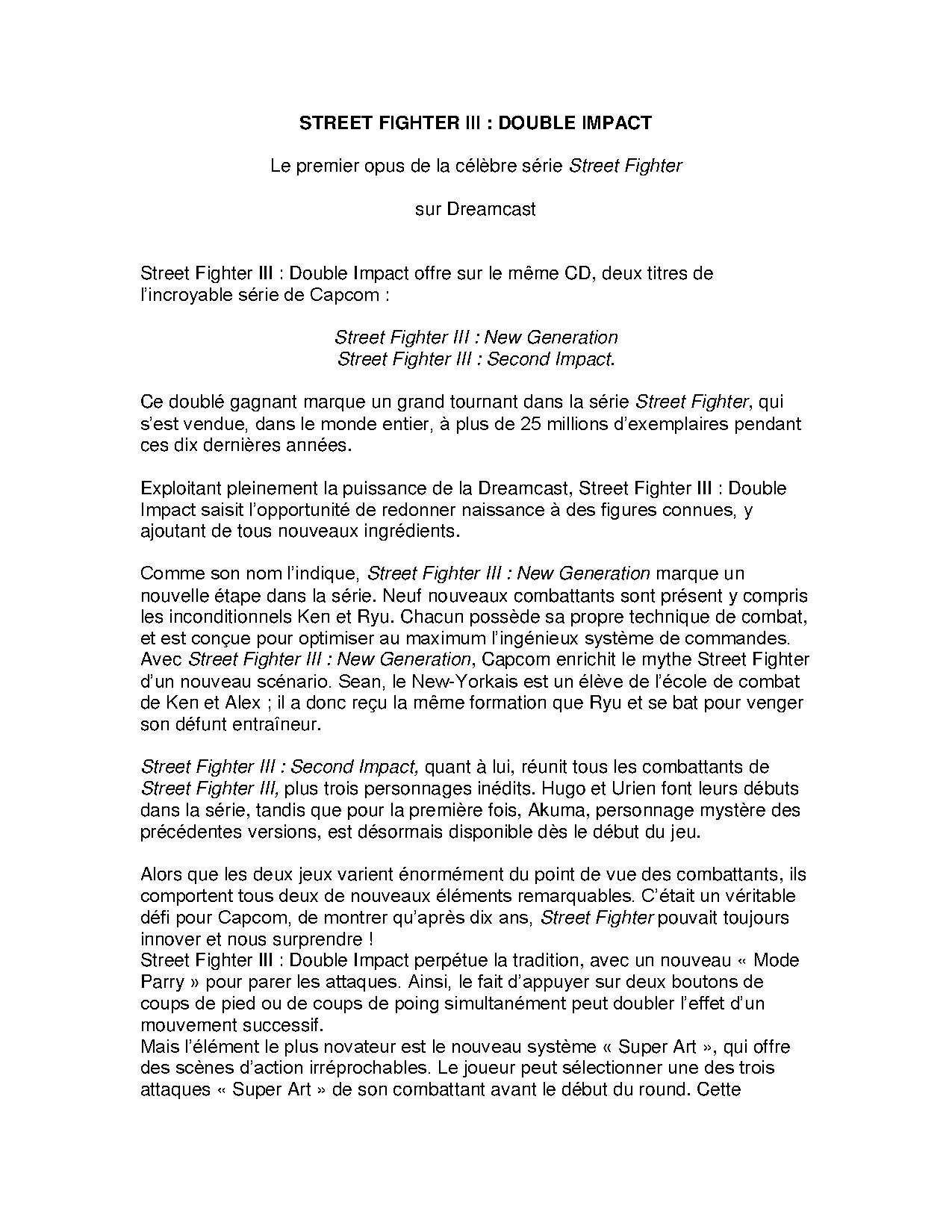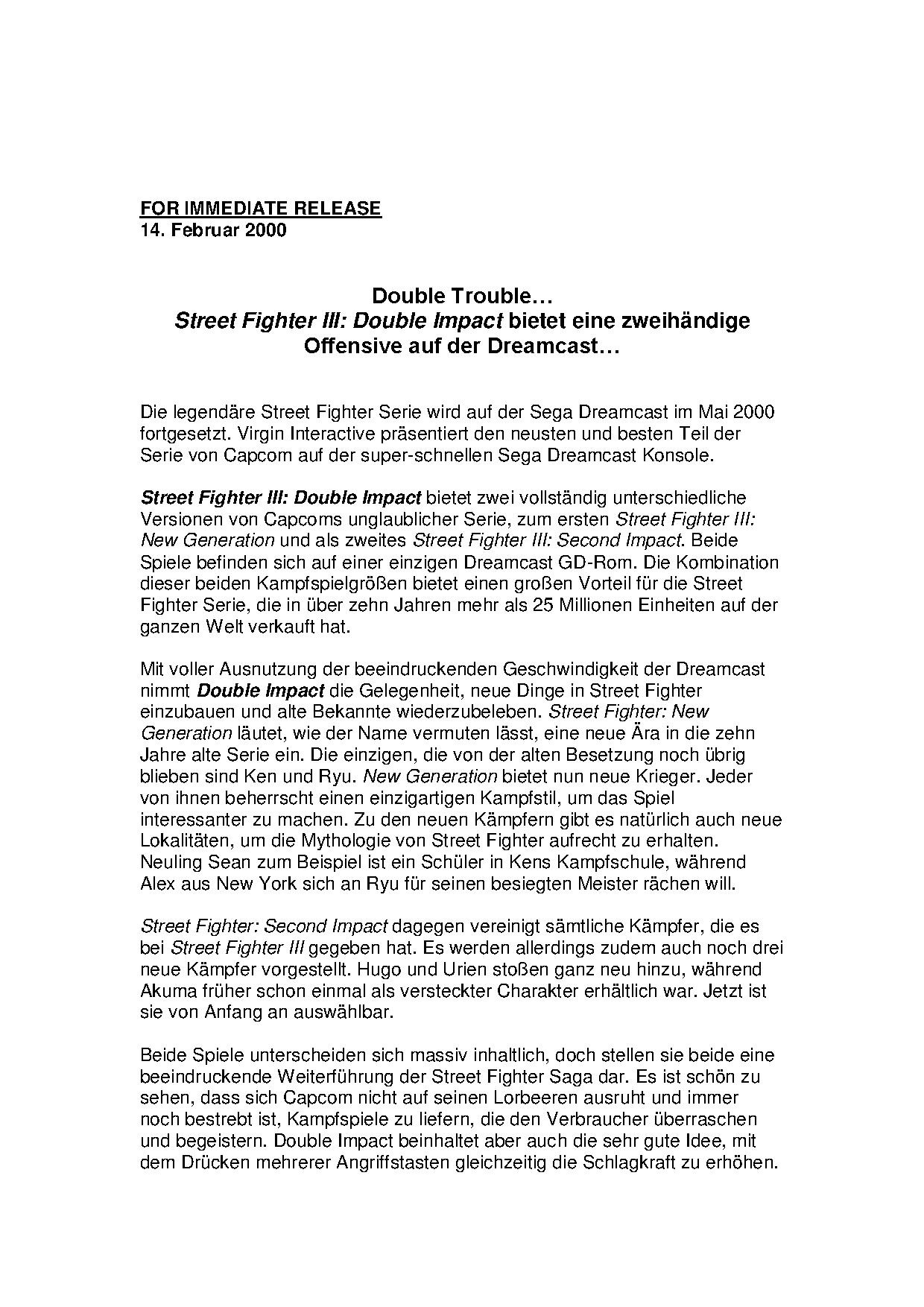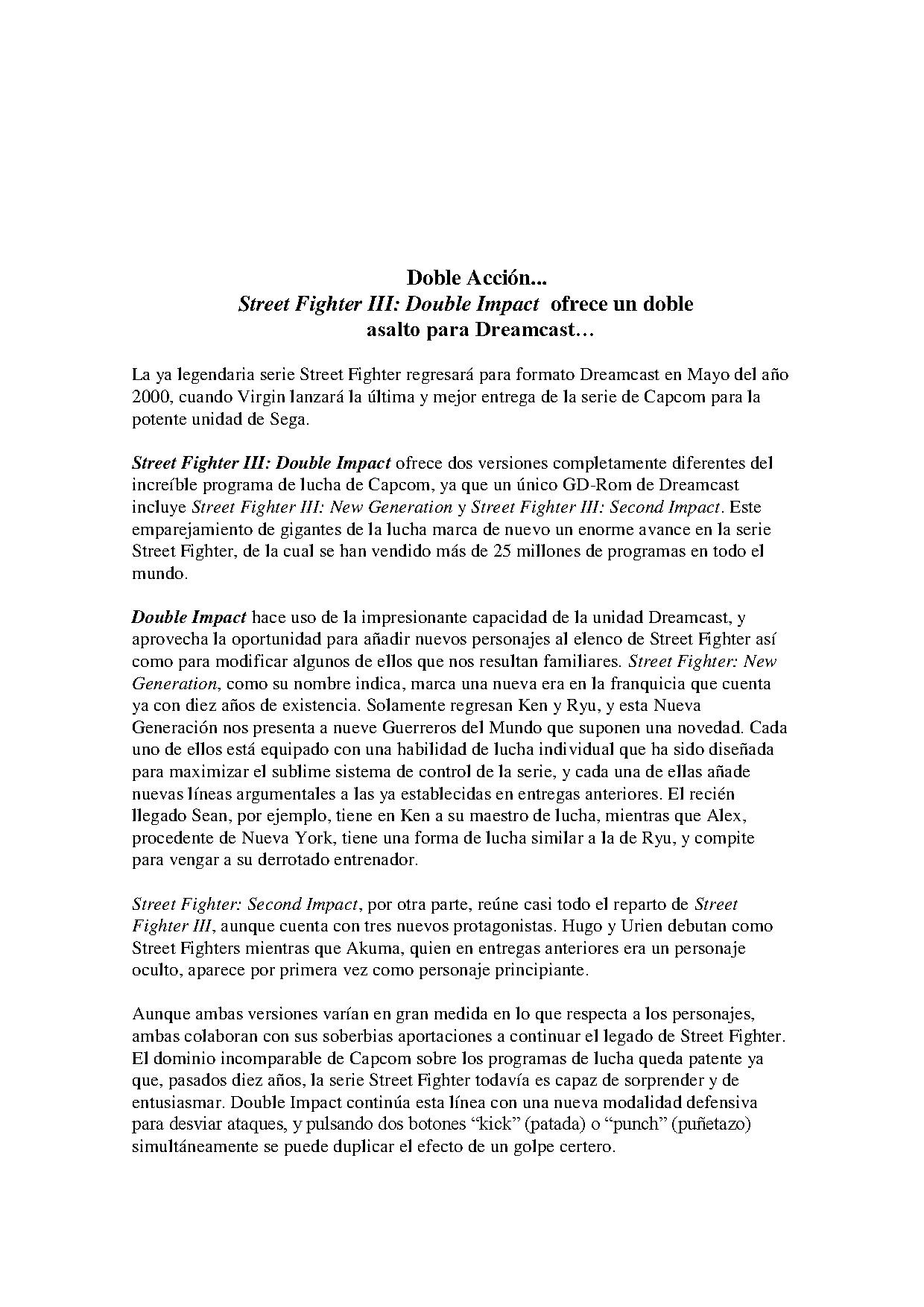Difference between revisions of "Street Fighter III: Double Impact"
From Sega Retro
(screenshots) |
(→Characters: returning characters) |
||
| Line 87: | Line 87: | ||
===Characters=== | ===Characters=== | ||
Move lists assume the player is facing right. If facing left, {{left}} and {{right}} should be reversed. {{punch}} refers to any of the punch buttons, while {{kick}} refers to any of the kick buttons. | Move lists assume the player is facing right. If facing left, {{left}} and {{right}} should be reversed. {{punch}} refers to any of the punch buttons, while {{kick}} refers to any of the kick buttons. | ||
| + | |||
| + | In ''New Generation'', Ryu and Ken are the only characters to return from previous entries. In ''2nd Impact'', Akuma returns as well, as a hidden character. | ||
Hugo and Urien were added in ''2nd Impact''. Additionally, Yun and Yang are the same character in ''New Generation'' ({{punch}} selects Yun and {{kick}} selects Yang), but they were split into separate characters for ''2nd Impact'', with differentiated movesets. | Hugo and Urien were added in ''2nd Impact''. Additionally, Yun and Yang are the same character in ''New Generation'' ({{punch}} selects Yun and {{kick}} selects Yang), but they were split into separate characters for ''2nd Impact'', with differentiated movesets. | ||
Revision as of 21:23, 11 September 2023
| ||||||||||||||||||||||||||||||||||||||||||||||||||
| Street Fighter III: Double Impact | ||||||||||||||||||||||||||||||||||||||||||||||||||
|---|---|---|---|---|---|---|---|---|---|---|---|---|---|---|---|---|---|---|---|---|---|---|---|---|---|---|---|---|---|---|---|---|---|---|---|---|---|---|---|---|---|---|---|---|---|---|---|---|---|---|
| System(s): Sega Dreamcast | ||||||||||||||||||||||||||||||||||||||||||||||||||
| Publisher: Capcom (Japan, US), Virgin Interactive (Europe) | ||||||||||||||||||||||||||||||||||||||||||||||||||
| Developer: Capcom | ||||||||||||||||||||||||||||||||||||||||||||||||||
| Original system(s): Capcom CPS-3 | ||||||||||||||||||||||||||||||||||||||||||||||||||
| Game total: 2 | ||||||||||||||||||||||||||||||||||||||||||||||||||
| Peripherals supported: Dreamcast Arcade Stick, Jump Pack, Dreamcast Modem, Visual Memory Unit, Dreamcast VGA Box | ||||||||||||||||||||||||||||||||||||||||||||||||||
| Genre: Fighting/Taisen Kakutou (対戦格闘)[1][2], Action[3] | ||||||||||||||||||||||||||||||||||||||||||||||||||
| Number of players: 1-2 | ||||||||||||||||||||||||||||||||||||||||||||||||||
|
Street Fighter III: Double Impact, known as Street Fighter III: W Impact (ストリートファイターIII Wインパクト) in Japan, is a competitive fighting game compilation produced by Capcom, released exclusively for the Sega Dreamcast in Japan in 1999 and worldwide in 2000.
It collects the first two versions of Street Fighter III, the long-awaited numbered sequel to Street Fighter II, originally released in arcades for Capcom's CPS-3 arcade board in 1997. Because of the advanced capabilities of the CPS-3, neither game could be ported to consoles until the Dreamcast was released over two years later.
Contents
Games included
- Street Fighter III: New Generation
- Street Fighter III 2nd Impact: Giant Attack
Story
Years after the second World Warrior Tournament and the fall of Shaladoo, a third World Warrior Tournament is being held by a mysterious "secret society" called the Illuminati.
Gameplay
Like the Street Fighter II and Street Fighter Alpha series that preceded it, Street Fighter III is a 2D fighting game. Two fighters must employ a variety of attacks and special moves to try to knock each other out in matches played to the best of three rounds. Character sprites are more detailed and have more fluid animation than in previous entries. Gameplay incorporates some features from previous Street Fighter games, as well as Capcom's Darkstalkers series and Marvel-based fighting games such as X-Men: Children of the Atom. New Generation introduced parrying (called "blocking" in the Japanese version), which can be used to deflect incoming attacks without receiving damage; leap attacks, which are small jumping attacks used against crouching opponents; and Super Arts, which are powerful special moves similar to the Super Combos of previous games. 2nd Impact added new characters, new moves for existing characters, Personal Actions, and EX Specials, while refining existing mechanics.
Characters move with ![]() and
and ![]() and crouch with
and crouch with ![]() . They dash with
. They dash with ![]()
![]() or
or ![]()
![]() . They jump with
. They jump with ![]() and flip back and forth with
and flip back and forth with ![]() and
and ![]() . Characters can perform a high jump with
. Characters can perform a high jump with ![]()
![]() (which varies in height depending on the character). Each character has a set of normal attacks with differing properties such as speed or range. Punches are performed with
(which varies in height depending on the character). Each character has a set of normal attacks with differing properties such as speed or range. Punches are performed with ![]() (jab),
(jab), ![]() (medium), and
(medium), and ![]() (fierce), while kicks are performed with
(fierce), while kicks are performed with ![]() (short),
(short), ![]() (medium), and
(medium), and ![]() (roundhouse). Light attacks start up and recover faster and have a higher likelihood of connecting to an opponent. Hard attacks deal more damage but have lower attack priority and leave the character vulnerable for longer while the move starts up and recovers. Characters can additionally perform unique special moves using particular button combinations. In 2nd Impact, characters can perform a Personal Action by pressing the hard punch and kick buttons simultaneously (
(roundhouse). Light attacks start up and recover faster and have a higher likelihood of connecting to an opponent. Hard attacks deal more damage but have lower attack priority and leave the character vulnerable for longer while the move starts up and recovers. Characters can additionally perform unique special moves using particular button combinations. In 2nd Impact, characters can perform a Personal Action by pressing the hard punch and kick buttons simultaneously (![]() +
+![]() by default). Personal Actions are similar to taunts but with unique effects for each character.
by default). Personal Actions are similar to taunts but with unique effects for each character.
Throws and grabs are done by holding ![]() or
or ![]() when next to an opponent and pressing a medium or hard punch or kick button. Different characters have different throws available to them, and some characters can throw in midair. Throws cannot be blocked, but characters can recover more quickly after being knocked down (from a throw or other attack) by pressing
when next to an opponent and pressing a medium or hard punch or kick button. Different characters have different throws available to them, and some characters can throw in midair. Throws cannot be blocked, but characters can recover more quickly after being knocked down (from a throw or other attack) by pressing ![]() upon landing on the ground. In 2nd Impact, characters can also recover from throws in the air by performing the same inputs as a throw, as in Super Street Fighter II Turbo.
upon landing on the ground. In 2nd Impact, characters can also recover from throws in the air by performing the same inputs as a throw, as in Super Street Fighter II Turbo.
Guarding is done by holding the D-Pad away from the opponent, which negates incoming damage. Special moves and Super Arts still do a small amount of tick damage when guarded. Characters can guard while standing or crouching, but not while jumping (unlike the Street Fighter Alpha games). Some attacks can only be guarded while crouching (such as sweeps) or while standing (called overheads). Every character now has access to a leap attack, performed with ![]()
![]() and any attack button, which can hit characters who are guarding while crouched. Characters have visible stun meters under their vitality meters that fill as they take repeated attacks (and empty as they avoid attacks). If the meter fills, the character becomes stunned and vulnerable to attack for a moment. Players can recover from stuns and escape grabs more quickly by rapidly pressing back and forth on the D-Pad along with the attack buttons.
and any attack button, which can hit characters who are guarding while crouched. Characters have visible stun meters under their vitality meters that fill as they take repeated attacks (and empty as they avoid attacks). If the meter fills, the character becomes stunned and vulnerable to attack for a moment. Players can recover from stuns and escape grabs more quickly by rapidly pressing back and forth on the D-Pad along with the attack buttons.
Characters can now parry incoming attacks by pressing the D-Pad toward the opponent to parry a standing or a jumping attack or pressing ![]() to parry a crouching attack. If executed at the exact moment that the attack is about to hit the character, the character flashes blue and averts the incoming attack; however, if the timing is wrong, the character is instead hit by the attack. Since performing a parry requires foregoing the option to guard because of the mutually exclusive controls, it is considered a high risk maneuver. Parrying can be used against normal and special moves as well as some Super Arts, but not against throws or grabs. The parrying character recovers much more quickly than attacking character, creating an opening for a counterattack. In 2nd Impact, characters can parry in midair.
to parry a crouching attack. If executed at the exact moment that the attack is about to hit the character, the character flashes blue and averts the incoming attack; however, if the timing is wrong, the character is instead hit by the attack. Since performing a parry requires foregoing the option to guard because of the mutually exclusive controls, it is considered a high risk maneuver. Parrying can be used against normal and special moves as well as some Super Arts, but not against throws or grabs. The parrying character recovers much more quickly than attacking character, creating an opening for a counterattack. In 2nd Impact, characters can parry in midair.
As in previous games, characters have a Super meter that fills as they perform normal moves (except for light attacks) or special moves (including Personal Actions). After selecting a character, the player can choose from one of three "Super Arts," which are super moves that can be performed once the Super meter is full. Only one Super Art can be chosen at a time, and the choice is permanent until the game ends. The length of the Super meter as well as the number of levels varies depending on the Super Art chosen, but every Super Art only costs one level of meter to perform. Generally, more powerful Super Arts require filling a longer meter while less powerful Super Arts have a shorter meter and allow the player to store multiple levels so that the move can be performed more. Normal and special moves can be canceled into Super Arts for combination attacks. Super meter power is carried over between rounds but not between matches.
In 2nd Impact, characters can also perform slightly more powerful versions of their special moves called EX Specials, which are similar to the ES moves introduced in Darkstalkers. These moves are performed by inputting the command for the special move and pressing two attack buttons of the same type (such as two punch buttons) instead of one. Using an EX Special costs a portion of the Super meter, depending on the move performed.
If a match goes three rounds without a victor (because of a draw or a double knockout), rather than continuing to a fourth round, three "Judgment Girls," female judges with different designs, walk out and decide the winner (based on unknown criteria).
Modes
Both games contain the same modes:
- Arcade: A single-player mode where the player faces a series of challengers in best of three matches before facing a final boss. A second player can challenge the first by pressing START , with the victor of the match continuing the game. There are eight difficulty levels for computer-controlled opponents. In New Generation, the player faces six opponents, then Gill. In 2nd Impact, the player faces eight opponents, with the last opponent varying depending on the selected character; it is usually Gill, but Gill is fought as the second-to-last opponent when it is someone else. The player can also face a rival character or Akuma if certain requirements are met. There is a bonus stage that is played after the third battle where Sean throws basketballs that the player must parry.
- Versus: A two-player mode where each player chooses a character, their Super Arts, and a handicap and can pick any stage. Players can choose a different Super Art for each round.
- Training: A practice mode where the player chooses a character and a Super Art for both fighters. The player can set the opponent to stand, crouch, jump, or fight and also toggle guarding and enable infinite Super meter.
- Parrying Attack: This mode is exclusive to 2nd Impact. It allows the player to play the bonus stage from the Arcade Mode to practice parrying.
Characters
Move lists assume the player is facing right. If facing left, ![]() and
and ![]() should be reversed. P refers to any of the punch buttons, while K refers to any of the kick buttons.
should be reversed. P refers to any of the punch buttons, while K refers to any of the kick buttons.
In New Generation, Ryu and Ken are the only characters to return from previous entries. In 2nd Impact, Akuma returns as well, as a hidden character.
Hugo and Urien were added in 2nd Impact. Additionally, Yun and Yang are the same character in New Generation (P selects Yun and K selects Yang), but they were split into separate characters for 2nd Impact, with differentiated movesets.
EX Specials and Personal Actions are only present in 2nd Impact. Rival battles and final battles also only apply to 2nd Impact (as New Generation lacks rival battles and always ends with Gill).
Rival battle: Sean
Final battle: Ken
|
Ryu |
| Ryu seeks to find worthy opponents and better his skills. | |
Rival battle: Ken
Final battle: Gill
|
Alex |
| Alex is a grappler who wants to avenge the defeat of his friend Tom at the hands of Gill. | |
Rival battle: Urien
Final battle: Yang
|
Yun |
| Yun is a kung fu expert from Hong Kong. He and his twin brother Yang are guardians of their hometown. In New Generation, the two brothers are the same character and have the same moves; Yun is selected with P. | |
Rival battle: Ibuki
Final battle: Gill
|
Necro |
| Necro is a Russian man who was kidnapped and experimented on by Gill's organization. | |
Rival battle: Elena
Final battle: Gill
|
Ibuki |
| Ibuki is an aspiring ninja who was sent to retrieve the "G File" from Gill's organization, which documents all of their plans. She is always accompanied by her pet tanuki Don-chan. | |
Rival battle: Yun
Final battle: Ryu, Necro, Elena, or Gill
|
Hugo |
| Hugo is a professional wrestler from Germany who seeks a strong tag team partner for an upcoming tournament. He is often accompanied by his manager, Poison. Hugo is based on Andore, an enemy character from Final Fight. | |
Rival battle: Yang
Final battle: Ken
|
Sean |
| Sean is a young Japanese-Brazilian fighter who becomes Ken's self-appointed apprentice. | |
Rival battle: Alex
Final battle: Gill
|
Urien |
| Urien is Gill's younger brother, who seeks to usurp his brother's leadership. He can manipulate electricity and metal. | |
Rival battle: Ryu
Final battle: Gill
|
Elena |
| Elena is an African princess from Kenya who uses the fighting style of capoeira. She seeks to make new friends. All of her attacks use her legs or feet (including punch button attacks). | |
Rival battle: Necro
Final battle: Gill
|
Oro |
| Oro is a seclusive hermit who seeks a fighter worthy to inherit his fighting style. He binds one arm while fighting to keep from accidentally killing his opponent. | |
Rival battle: Oro
Final battle: Yun
|
Yang |
| Yang is a kung fu expert from Hong Kong. He and his twin brother Yun are guardians of their hometown. In New Generation, the two brothers are the same character and have the same moves; Yun is selected with K. | |
Rival battle: Hugo
Final battle: Gill
|
Dudley |
| Dudley is a gentleman British boxer who seeks to recover his late father's antique Jaguar convertible from Gill. All of his attacks use his arms or fists (including kick button attacks). | |
Rival battle: Sean
Final battle: Ryu
|
Ken |
| Ken is the current American martial arts champion. He seeks to test his strength against his old friend and rival Ryu once again. |
Bosses
Gill is playable in 2nd Impact with the use of a cheat code.
Hidden
- Main article: Street Fighter III: Double Impact/Hidden content.
Akuma and Shin Akuma are only present in 2nd Impact and playable through the use of cheat codes.
Rival battle: Sean
Final battle: Gill
|
Akuma (Gouki) | |||||||||||||||||||||||||||||||||||||||||||||||||||||||||||
Akuma is an emotionless and powerful warrior who is obsessed with obtaining power and battling stronger foes. Akuma and Shin Akuma can be fought in the single-player game if certain conditions or met, and they are also playable.
|
Stages
Each character has his or her own stage where matches are hosted. The stage can be manually chosen in the two-player mode.
Street Fighter III: New Generation
Street Fighter III 2nd Impact: Giant Attack
History
Development
- Main article: Street Fighter III: Double Impact/Development.
Legacy
The third and final game in the series, Street Fighter III: 3rd Strike, was released to arcades in 1999. The Dreamcast would receive a standalone port of it in 2000.
Though 3rd Strike would be re-released for several other platforms (including the PlayStation 2 and the Xbox in the same console generation), this compilation was the only console port of New Generation and 2nd Impact until the release of Street Fighter 30th Anniversary Collection for the Nintendo Switch, PlayStation 4, Xbox One, and Windows PCs in 2018.
Capcom has retroactively changed the story from taking place during the third World Warrior tournament to the fifth, since Street Fighter IV (2008) and Street Fighter V (2016) are supposed to have taken place in between Street Fighter II and Street Fighter III. Street Fighter 6 (2023) is the first game to take place after the events of Street Fighter III.
Versions
Localised names
| Language | Localised Name | English Translation |
|---|---|---|
| English | Street Fighter III: Double Impact | Street Fighter III: Double Impact |
| Japanese | ストリートファイターIII Wインパクト | Street Fighter III: W Impact |
Production credits
Street Fighter III: New Generation
- Character Design: Hitoshi "T" Nishio, Ball Boy, Q, Yu‑Suke, Who, Toru Takaoka, G.Kamina, D‑Kurita, Shibaki, Tuyoshi, Yoshioka, Chun, Norihide, Chimorin Shogun, Yuki Ishikawa, Syuucyan, Ken, Koki. K, Seiji Yano, Jun Ikawa, Otokonoyama
- Scroll Design: Hiroyuki Imahori, Hiroki Ohnishi, Yoko Fukumoto, Yuki Kyotani, Tama, Chie Morisaki, Hiroshi Sugiyama, Koji Yamamoto, Yumiko. N, Takako Nakamura, Yasuto Takahashi, Kazumi Teramoto, Yoichi Tanoue, Shinnosuke. N, Naoko Niiyama
- Original Art Work: Akiman, Kinu Nishimura
- Sound Effect: Satoshi Ise
- Music Compose: Hideki Okugawa, Yuki Iwai
- Programmer: Kazuhito Nakai, Nobuya "LT1" Yoshizumi, Yuko Kawamura (Tate), Hiroshi Nakagawa, Hard・Yas -Assist-, Akihiro Yokoyama
- CP-SystemⅢ Programmer: Yoji "X68k" Mikami
- Planner: Yasuhiro Seto, Numach the Nikolist, S.Obata AE-86 Trueno, Malachie du Marais, Neo_G -H.Ishizawa-
- Voice Actor: Yuri Amano, Wataru Takagi, Isshin Chiba, Kan Tokumaru, Koji Tobe, Kahoru Fujino, Bruce Robertson, Michael Sommers
- Special Thanks: Takuya Shiraiwa, Naoki Fukushima, Sayuri Shintani, Shoei, Sakomizu, Rita Rokos
- Translator: Matt Taylor, Erik Suzuki, Jesus Rodriguez Bueno, Harumi Yamashita
- Producer: Tomoshi Sadamoto
- General Producer: Noritaka Funamizu, Yoshiki Okamoto
- And Capcom All Staff
- Presented by: Capcom
Street Fighter III 2nd Impact: Giant Attack
- Character Design: Who, D‑Kurita, Chimorin Shogun, Shibaki, Chun, Jun Ikawa, Seiji Yano, Yuki Ishikawa, Shinnosuke. N
- Scroll Design: Hiroshi Sugiyama, Yoko Fukumoto, Hiroyuki Imahori, Ojiji, Naobei, Akemi Kohama, Tama, Koji Yamamoto, Kouichi Takeda
- Original Art Work: Akiman, Kinu Nishimura, NK
- Title Logo Design: Shoei
- Instruction Design: Sakomizu
- Programming: Kazuhito Nakai, Nobuya "LT1" Yoshizumi, Yuko Kawamura (Tate), Hiroshi Nakagawa, Yoshinobu Inada (Ine), Masahito Oh!Ya!, Akihiro Yokoyama
- Sound Effect Design: Satoshi Ise, Hiroaki "X68k" Kondo
- Music Compose: Hideki Okugawa, Yuki Iwai
- Music Arrangement: Hideki Okugawa
- Planning: Yasuhiro Seto, Neo.G - H.Ishizawa -, Numach
- Voice Actor: Yuji Ueda, Wataru Takagi, Tomomichi Nishimura, Kahoru Fujino, Yuri Amano, Isshin Chiba, Kan Tokumaru, Koji Tobe, Bruce Robertson, Michael Sommers
- Message Translator: Erik Suzuki, Dan Okada, Chris Tang, Yumiko Nishi, Karka Oshiro de Freitas
- Special Thanks: Tsuyoshi, Mayano, Tomo, Blbon, Takafumi Sagata, M.Aoki, N.Akei, H.Nakamura, H.Ojima, Yoji "X68k" Mikami, Takuya Shiraiwa, Rita Rokos, Ryoji, Hard・Yas -Follow-
- Special Thanks (CS Bug Checkers ): Kunishige Matsubara, Manabu Matsumoto, Tomoyuki Yokota, Tetsuya Haze, Katsusuke Miura, Masahiro Kajitani, Takashi Hashimoto, Toshihiko Kurata, Yoshihiro Tomita, Daisuke Sasaki, Akinori Murata
- Special Thanks (Skill Smith - Test Play ): TTK-K.S, Hiroshi Sugimoto-Bug, Gon, Kohsuke-Arai (Tko)
- Producer: Tomoshi Sadamoto
- General Producer: Noritaka Funamizu, Yoshiki Okamoto
- And Capcom All Staff
- Presented by: Capcom
Magazine articles
- Main article: Street Fighter III: Double Impact/Magazine articles.
Promotional material
also published in:
- Official Dreamcast Magazine (US) #7: "September/October 2000" (2000-08-01)[17]
- Electronic Gaming Monthly (US) #134: "September 2000" (2000-08-08)[18]
- Official Dreamcast Magazine (US) #10: "Holiday 2000" (2000-11-28)[19]
- GamePro (US) #145: "October 2000" (2000-xx-xx)[20]
- Official Dreamcast Magazine (US) #12: "March 2001" (2001-01-28)[21]
Physical scans
| Sega Retro Average | |||||||||||||||||||||||||||||||||||||||||||||||||||||||||||||||||||||||||||||||||||||||||||||||||||||||||||||||||||||||||||||||||||||||||||||||||||||||||||||||||||||||||
|---|---|---|---|---|---|---|---|---|---|---|---|---|---|---|---|---|---|---|---|---|---|---|---|---|---|---|---|---|---|---|---|---|---|---|---|---|---|---|---|---|---|---|---|---|---|---|---|---|---|---|---|---|---|---|---|---|---|---|---|---|---|---|---|---|---|---|---|---|---|---|---|---|---|---|---|---|---|---|---|---|---|---|---|---|---|---|---|---|---|---|---|---|---|---|---|---|---|---|---|---|---|---|---|---|---|---|---|---|---|---|---|---|---|---|---|---|---|---|---|---|---|---|---|---|---|---|---|---|---|---|---|---|---|---|---|---|---|---|---|---|---|---|---|---|---|---|---|---|---|---|---|---|---|---|---|---|---|---|---|---|---|---|---|---|---|---|---|---|---|
|
| 73 | |
|---|---|
| Based on 33 reviews | |
Technical information
- Main article: Street Fighter III: Double Impact/Technical information.
ROM dump status
| System | Hash | Size | Build Date | Source | Comments | |||||||||
|---|---|---|---|---|---|---|---|---|---|---|---|---|---|---|
| ? |
|
GD-ROM (JP) | ||||||||||||
| ? |
|
GD-ROM (US) | ||||||||||||
| ? |
|
GD-ROM (EU) | ||||||||||||
| ? |
|
2000-01-13 | GD-R | Page |
External links
- Capcom USA webpage: Dreamcast
- Sega of America webpage: Dreamcast
- Sega of Japan catalogue pages (Japanese): Dreamcast
References
- ↑ File:SF3DI DC JP Box Back.jpg
- ↑ 2.0 2.1 2.2 http://sega.jp/dc/991030/ (Wayback Machine: 2014-08-03 22:38)
- ↑ https://sega.jp/history/hard/dreamcast/software_l.html#tab01 (Wayback Machine: 2020-02-01 22:57)
- ↑ http://www.sega.com:80/pc/catalog/SegaProduct.jhtml?PRODID=204&CATID=71 (Wayback Machine: 2003-11-25 13:58)
- ↑ Official Dreamcast Magazine, "May/June 2000" (US; 2000-04-04), page 95
- ↑ http://www.chipsworld.co.uk/detProd.asp?ProductCode=2869 (Wayback Machine: 2003-11-26 06:05)
- ↑ 7.0 7.1 Computer & Video Games, "June 2000" (UK; 2000-05-17), page 92
- ↑ 8.0 8.1 Dreamcast Magazine, "No. 8" (UK; 2000-04-20), page 68
- ↑ http://www.amazon.de:80/exec/obidos/ASIN/B00004TNWG (Wayback Machine: 2004-10-28 04:44)
- ↑ 10.0 10.1 Sega Magazin, "August 2000" (DE; 2000-07-03), page 16
- ↑ http://www.micromania.fr/zooms/?ref=17913 (Wayback Machine: 2003-02-24 17:08)
- ↑ http://www.centromail.es/top/ficha.asp?codmail=15139 (Wayback Machine: 2002-05-04 16:23)
- ↑ http://www.futuregamez.net:80/outnow/dc.html (Wayback Machine: 2001-07-31 23:17)
- ↑ 14.0 14.1 Hyper, "October 2000" (AU; 2000-08-23), page 73
- ↑ File:Street Fighter III New Generation DC credits.pdf
- ↑ File:Street Fighter III 2nd Impact DC credits.pdf
- ↑ Official Dreamcast Magazine, "September/October 2000" (US; 2000-08-01), page 45
- ↑ Electronic Gaming Monthly, "September 2000" (US; 2000-08-08), page 87
- ↑ Official Dreamcast Magazine, "Holiday 2000" (US; 2000-11-28), page 116
- ↑ GamePro, "October 2000" (US; 2000-xx-xx), page 59
- ↑ Official Dreamcast Magazine, "March 2001" (US; 2001-01-28), page 49
- ↑ Ação Games, "Fevereiro 2000" (BR; 2000-xx-xx), page 30
- ↑ Arcade, "May 2000" (UK; 2000-04-24), page 87
- ↑ Consoles +, "Février 2000" (FR; 2000-0x-xx), page 114
- ↑ Dreamcast Monthly, "April 2000" (UK; 2000-03-16), page 72
- ↑ DC-UK, "April 2000" (UK; 2000-03-16), page 16
- ↑ Dreamcast: Le Magazine Officiel, "Septembre/Octobre 2000" (FR; 2000-0x-xx), page 68
- ↑ Dreamcast Magazine, "1999-39 extra (1999-12-24ex)" (JP; 1999-12-10), page 26
- ↑ Dreamcast Magazine, "No. 5" (UK; 2000-01-27), page 76
- ↑ Dorimaga, "2002-18 (2002-10-11)" (JP; 2002-09-27), page 34
- ↑ Dreamzone, "Février 2000" (FR; 2000-01-xx), page 110
- ↑ Dreamzone, "Juillet/Août 2000" (FR; 2000-07-15), page 82
- ↑ Edge, "February 2000" (UK; 2000-01-26), page 83
- ↑ Electronic Gaming Monthly, "September 2000" (US; 2000-08-08), page 156
- ↑ Entsiklopediya igr dlya Dreamcast, "Izdaniye chetvertoye, dopolnennoye" (RU; 2002-xx-xx), page 245
- ↑ Famitsu, "1999-12-24" (JP; 1999-12-10), page 31
- ↑ Fun Generation, "02/2000" (DE; 2000-01-19), page 98
- ↑ GamePro, "May 2000" (US; 2000-0x-xx), page 104
- ↑ GameWEEK, "January 17, 2000" (US; 2000-01-17), page 16
- ↑ Joypad, "Febbraio 2000" (IT; 2000-0x-xx), page 73
- ↑ MAN!AC, "03/2000" (DE; 2000-02-02), page 38
- ↑ MAN!AC, "08/2000" (DE; 2000-07-05), page 55
- ↑ Mr. Dreamcast, "June 2000" (UK; 2000-04-27), page 70
- ↑ Neo Plus, "Listopad 2000" (PL; 2000-xx-xx), page 46
- ↑ Next Generation, "October 2000" (US; 2000-09-19), page 112
- ↑ Official Dreamcast Magazine, "June 2000" (UK; 2000-05-11), page 84
- ↑ Official Dreamcast Magazine, "May/June 2000" (US; 2000-04-04), page 94
- ↑ Play, "Styczeń 2001" (PL; 2001-xx-xx), page 40
- ↑ Play, "Lipiec 2001" (PL; 2001-xx-xx), page 20
- ↑ Video Games, "06/2000" (DE; 2000-05-04), page 84
| Street Fighter III: Double Impact | |
|---|---|
|
Main page | Comparisons | Hidden content | Development | Magazine articles | Reception | Technical information | Bootlegs
Demos: Street Fighter III: W Impact Tentou Taikenban (1999)
Prototypes: 2000-01-13
| |
| Street Fighter games for Sega systems | |
|---|---|
| Street Fighter II': Champion Edition (unreleased) | Street Fighter II': Special Champion Edition (1993) | Super Street Fighter II: The New Challengers (1994) | |
| Street Fighter: The Movie (1995) | Street Fighter Alpha: Warriors' Dreams (1996) | Street Fighter II Movie (1996) | Street Fighter Alpha 2 (Dash) (1996) | Super Puzzle Fighter II Turbo (1996) | Street Fighter Collection (1997) | X-Men vs. Street Fighter (1997) | Pocket Fighter (1998) | Marvel Super Heroes vs. Street Fighter (1998) | Capcom Generation: Dai 5 Shuu Kakutouka-tachi (1998) | Street Fighter Zero 3 (1999) | |
| Street Fighter II' (1997) | |
| Street Fighter Alpha 3 (1999) | Street Fighter III: Double Impact (1999) | Street Fighter III: 3rd Strike (2000) | Super Street Fighter II X for Matching Service (2000) | Street Fighter Zero 3 for Matching Service (2001) | Super Puzzle Fighter II X for Matching Service (2001) | |
| Street Fighter Zero 3 Upper (2001) | |
| Sampler discs | |
| Street Fighter Zero 2 Taikenban (199x) | Street Fighter Collection Taikenban (1997) | |
| Street Fighter Zero 3 Tentou Taikenban (199x) | |
| Unlicensed Street Fighter games for Sega systems | |
| Jang Pung II (1993) | |
| X-Men vs. Street Fighter (Mega Drive) (1998) | |
- Dreamcast Arcade Stick-compatible games
- Jump Pack-compatible games
- Dreamcast Modem-compatible games
- Dreamcast VGA Box-compatible games
- Visual Memory Unit-compatible games
- 1-2 player games
- JP Dreamcast games
- All JP games
- US Dreamcast games
- All US games
- EU Dreamcast games
- All EU games
- DE Dreamcast games
- All DE games
- ES Dreamcast games
- All ES games
- FR Dreamcast games
- All FR games
- UK Dreamcast games
- All UK games
- AU Dreamcast games
- All AU games
- Dreamcast games
- 1999 Dreamcast games
- All 1999 games
- Dreamcast fighting games
- All fighting games
- Dreamcast games with ADX audio
- Dreamcast games using Flash
- Dreamcast games with QSound support
- All games
- Pages with broken file links
- Missing ROM hashes
- Games with known prototypes
- Old technical information
- Street Fighter III: Double Impact
- Street Fighter



